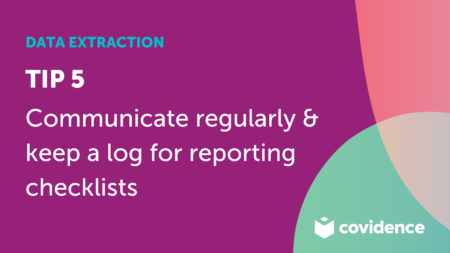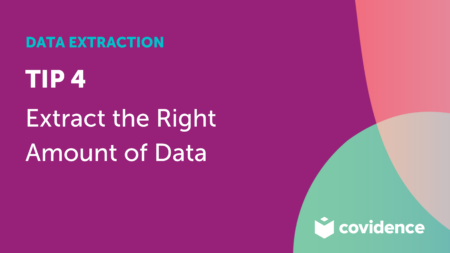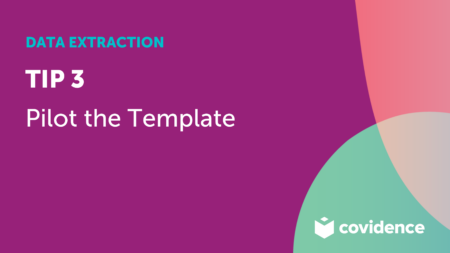Engaging with your supervisor to support your systematic review
Suppose you are embarking on a systematic review that will form part of your postgraduate research project. It’s a good idea to pause and think about how you will engage with your supervisor throughout this process. We asked Benita Olivier, personal professor in sports physiotherapy, Director of the Wits Cricket Research Hub for Science, Medicine and Rehabilitation, at the University of the Witwatersrand and supervisor to PhD students, for her suggestions to help students prepare where the research project involves a systematic review.
Let’s talk!
Having been a student and now a supervisor, I can attest that having an open and honest discussions early on is the best place to start. Instead of wondering how things will be done, don’t be scared to take action and set up a meeting with your supervisor to get your questions answered early on.
This takes guts and moves one out of your comfort zone, but it’s also one of those discussions that, if you don’t have it, things can really burn later in the process. Schedule the meeting in such a way so that you have a few days to think about all the things you would like to get clarity on. Prepare well for the meeting by writing your questions down. Often these questions may feel like you will be posing potential problems to your supervisor, but there’s nothing wrong with that if you are armed with a few potential solutions, wherever possible.
I’m a big fan of transparency and believe that hidden expectations need to be banned from this earth. Here are some things that will need clarification:
- The role of your supervisor and others in the systematic review
Some supervisors prefer to be involved in the systematic review as the second reviewer, while others prefer the third reviewer spot. Others prefer not to be a reviewer but will give guidance during each of the phases. The role of your supervisor as well as the inclusion of any other role players into the project, need to be discussed beforehand. This same conversation can include a frank discussion about co-authorship (here’s a video that can give guidance on that).
- Decide on the preferred platform of communication
Each individual has certain preferences regarding communication platforms that they feel most comfortable with, and a mutual agreement needs to be determined at the start of the journey. Some supervisors prefer to work via purely email and others prefer meetings, be it online or face-to-face. Some are happy to communicate via an instant messaging platform such as WhatsApp and yet others work well on shared platforms such as Google Docs.
- How often will you and your supervisor “check-in”?
Remember, this is your research project. You are the driver and the project manager. Your supervisor will guide you along the way and help overcome challenges you may encounter, but you are the one who will make sure there’s progress. Take into account, supervisors are human, and humans differ. So does one supervisor’s approach to the supervision process differ from another. Some supervisors put a lot of structure in place through regular pre-scheduled meetings, co-writing sessions and group supervision sessions, to mention a few initiatives. Sometimes these structures are put in place at an institutional level. Other supervisors leave it up to the student to create their own structure. Tap into the systems already in place, and if there is none, create a structure that will work for you and propose your suggestions to your supervisor.
When it comes to a systematic review, I’d say it will be great to check-in at the end of each phase and before you tackle the next phase. I’ll refer to these check-ins as pitstops, where you take a deep breath, reflect on what’s done and get ready for the next step.
Negotiate these pitstops with your supervisor: where in the journey will they be and what will they look like. I have seen many motivated students running with a systematic review, just to have to go back and restart the title and abstract review process, because the inclusion criteria was misinterpreted – something that could have been avoided through a quick check-in with the supervisor.
Of course, as a student, you need to work independently, but checking in with your supervisor regularly does not mean you are going there waiting for your supervisor to give you all the answers. Approach your supervisor with potential solutions and a plan, ready to tap into your supervisor’s experience to optimise your strategies to the fullest.
Suggested Pitstops
Here are some suggested pitstops. To get the most out of each pitstop, read up on the next phase and be armed with a plan. Your supervisor will help guide you, but you are the champion of your exciting project, so prepare thoroughly.
Pitstop #1: During the conceptualisation phase
This may take one or multiple meetings and emails. Don’t get despondent if you don’t have a clear idea within the first week. It’s a journey, and sometimes there are a few bushes to get through before you get to the daylight.
Pitstop #2: Throughout the protocol development phase
This phase often involves more than one draft, and you may feel like the forward and backward sending of drafts via email is never going to end. Don’t worry; the end will come (and then you’ll celebrate this phase with a real draught). Just hang in there. Spending a lot of time and energy here is crucial to make sure you work from a solid base.
Pitstop #3: Before you do your comprehensive search
It may take a few weeks after your supervisor blessed your proposal with the green light and you received approval from all other university structures. It’s now time to tackle your search strategy. The JBI Manual for Evidence Synthesis suggest a three-step search strategy, and your initial search is the first. This is quite an easy one to do, and you would have described the initial search well in your protocol, so get going and do your search as planned in your protocol. The initial search aims to find more search terms that you may not have thought about. Once you found more search terms, put them together in a table such as the one described in this video . Then, before you do your comprehensive search, it is time to check in with your supervisor again. Present your search terms and show how you will connect them with your Boolean operators and which subject headings (such as MeSH terms) you’ll include. This session is best when done via a live interaction so setting up a meeting should do the trick. Of course, we always recommend that an expert librarian get involved in this phase, but your supervisor’s insight into the topic will be invaluable.
Pitstop #4: Before you review all titles and abstracts
Once you have completed your comprehensive search strategy in all the relevant databases, it is time to decide which studies will make the cut. Well, you already made this decision when you put your protocol together, but after you have applied your inclusion/exclusion criteria to about 30 or so studies, check in with your supervisor again. Explain what you have done, where things were unclear and make a few suggestions as to how you will go about reviewing the remaining titles and abstracts. Remember, it’s also here where the second reviewer will be involved, so you need to feel comfortable and confident with this phase before you train your second reviewer.
Pitstop #5: Before you review all the full-text studies
Now that you have downloaded all the full-text studies based on the review of title and abstracts, you are ready to decide which of these full-texts will be in and which ones out. Again, go through the process by reviewing the first few full texts and checking in with your supervisor thereafter. State how you approached this phase, which challenges you encountered and how you dealt with them.
Pitstop #6: When it’s time to extract your data into a table
Extract the first five and run the draft table by your supervisor. This can be done via a brief email.
Pitstop #7: After you completed your meta-analyses
When you developed the protocol, you stated which meta-analyses you would conduct, so go on and do those. Often, as one deals with the data, you may realise that you can do other meta-analyses that you may not have thought about at the start. Some of the meta-analyses described in the protocol are not possible in the end. Read up, look at examples and do the meta-analyses. Present these to your supervisor before you start writing the discussion. Here, a live interaction, whether online or face-to-face, works quite well.
Pitstop #8: When it’s time for the write-up
Time to get that bum back on the seat for the home run. This phase often works well through reviewing drafts sent via email, but sometimes a meeting to plan your discussion chapter, helps a lot.
Disclaimer: Remember, each supervisor has his/her own supervision style, so while you may be suggesting the above, your supervisor may approach the supervision process differently and suggest alternative pitstops and communication strategies.
Discuss the roles of all parties, preferred platform of communication and pitstops with your supervisor at the start of your journey. Turn the potentially rough ride into a smooth one.
For more guidance for postgraduate students, subscribe to the Research Masterminds YouTube Channel and read more about the awesome Research Masterminds Success Academy for postgraduate students here!




